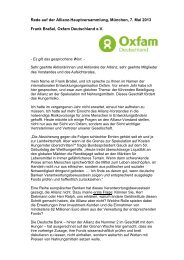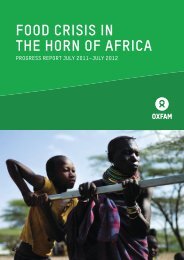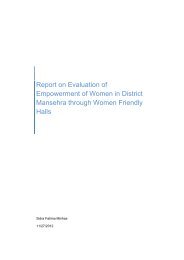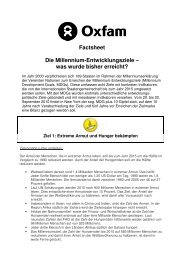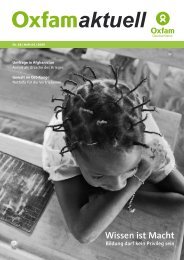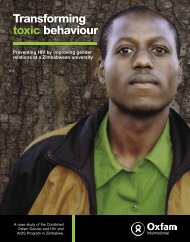No Time to Lose - Oxfam
No Time to Lose - Oxfam
No Time to Lose - Oxfam
You also want an ePaper? Increase the reach of your titles
YUMPU automatically turns print PDFs into web optimized ePapers that Google loves.
The Afghan National Security<br />
Forces<br />
Who’s Who in the ANSF?<br />
The ANSF includes both the ANA (which includes the Afghan Air<br />
Force) and the Afghan National Police (ANP). The term is also<br />
sometimes used <strong>to</strong> encompass the National Direc<strong>to</strong>rate of Security –<br />
Afghanistan’s intelligence services. The ANA falls under the<br />
authority of the Ministry of Defence; the ANP under the Ministry of<br />
Interior (MoI). There are also a number of community defence<br />
initiatives that do not fall within the formal structure of the ANSF but<br />
nonetheless receive some level of support from the government. 5 The<br />
professionalism and operational capacity of the different components<br />
of the ANSF have developed unevenly, with the ANA comparatively<br />
well regarded (albeit fraught with problems), the ANP lagging far<br />
behind, and community defence initiatives widely criticised for a lack<br />
of professionalism, abusive behaviour and a near complete absence of<br />
accountability. All components have been substantially expanded in<br />
recent years, and some improvements made, but in all cases the<br />
pressure <strong>to</strong> increase the number of boots on the ground has been at<br />
the expense of attention <strong>to</strong> the professionalism and accountability of<br />
the force. 6 As of March 2011, the ANSF comprised 159,363 ANA and<br />
134,000 ANP, with a target of 171,000 ANA and 134,000 ANP by<br />
Oc<strong>to</strong>ber 2011. 7<br />
The Afghan National Army<br />
The ANA is organised in<strong>to</strong> six corps in six regional commands. Each<br />
corps consists of several brigades, which are in turn made up of<br />
batallions, called kandaks. Each regional command holds at least one<br />
commando kandak. Since late 2010 the ANA has also fielded its own<br />
special forces teams, with recruits drawn from commando units,<br />
modelled on the US Special Forces. The ANA currently has lead<br />
responsibility for security in Kabul province, but in most of the rest of<br />
the country defers <strong>to</strong> the security lead responsibilty of international<br />
forces. As of September 2010, out of 26 ANA corps and brigades assessed<br />
by ISAF training teams, 17 were assessed as effective with assistance<br />
or advisors, and nine were assessed as ‘dependent on coalition<br />
forces for success.’ <strong>No</strong>ne were assessed as ‘independent’. 8<br />
The Afghan National Police<br />
The 2010 National Police Strategy describes four ‘main pillars’ of the<br />
ANP: the Afghan Uniformed Civilian Police (focusing on the core<br />
7






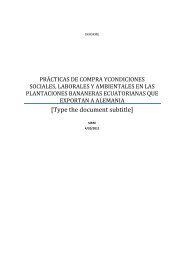
![Download: Faltposter EU-Handelspolitik [PDF 2,17MB] - Germanwatch](https://img.yumpu.com/25095854/1/190x161/download-faltposter-eu-handelspolitik-pdf-217mb-germanwatch.jpg?quality=85)
